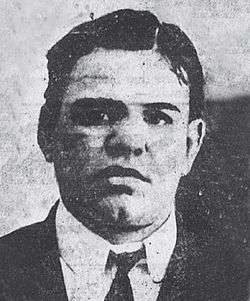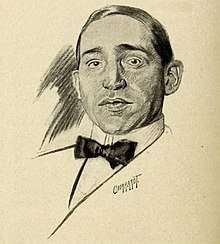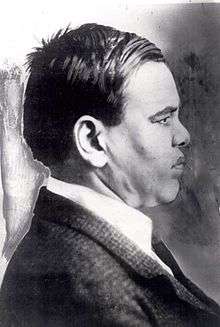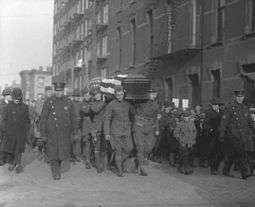Monk Eastman
Edward "Monk" Eastman (1875 – December 26, 1920) was a New York City gangster who founded and led the Eastman Gang in the late 19th and early 20th century; it became one of the most powerful street gangs in the city.[1] His aliases included Joseph "Joe" Morris, Joe Marvin, William "Bill" Delaney, and Edward "Eddie" Delaney. Eastman is considered to be one of the last of the 19th-century New York City gangsters who preceded the rise of Arnold Rothstein and the Jewish mob. Later, more sophisticated, organized criminal enterprises also included the predominately Italian Cosa Nostra.[2]
Monk Eastman | |
|---|---|
 1903 NYPD mugshot of Monk Eastman, taken from newspaper | |
| Born | Edward Eastman 1875 Manhattan, New York City, New York |
| Died | December 26, 1920 (aged 44–45) Manhattan, New York City, New York |
| Cause of death | Gunshot |
| Other names | Joseph Morris {August 1903} William Delany {December 1903} and {October 1917 enlistment in US Army}; John Marvin {February 1914} |
| Occupation | gangster; soldier; dockworker |
| Criminal status | served sentence-deceased |
| Parent(s) | Samuel Eastman and Mary Parks |
| Conviction(s) | 1904; 1912; 1915 |
| Criminal charge | 1901 reported wounded in gang fight December 1902 arrested on assault charge {acquitted} August 1903 arrested after gunfight with rival gang-charged with assault but not held 1903 arrested under own name in Freehold, New Jersey on charge of beating up coachman James McMahon {discharged} December 1903 arrested after Michael Donavon killed after gang fight-discharged; arrested twice as "suspicious person" but not held April 1904 arrested for assault-sent to Sing Sing for 10 years May 1912 arrested for manufacturing and using opium-sent to Sing Sing prison for eight months February 1914-arrested as "John Marvin" in Buffalo, New York on charge of Burglary {discharged} November 1915-arrested in Riverdale, New York on charge of stealing silver in Albany, New York-sent to Dannemora for two years and eleven months-released October 1917 |
| Penalty | Sing Sing and Dannemora |
Early life
Monk was born Edward Eastman in 1875 in the Corlear's Hook section of lower Manhattan to Samuel Eastman, a Civil War veteran and wallpaper-hanger, and his wife Mary (Parks) Eastman. They were descended from English ancestors of the colonial period. By the time Monk was five, his father had abandoned the family. Mary moved with her children to her father George Parks' home on the Upper East Side.
According to the 1880 United States Census, 5-year-old Edward Eastman lived with his mother and other family on East Seventy-Fifth Street, in Manhattan. The household was headed by his maternal grandfather George Parks, age 68, who worked in a dry goods store. Parks was born in New York, as were both his parents. In addition to Edward, the Eastman family included Mary Eastman, age 35; and her daughters Lizzie, age 10; Ida, age 8; and Francine, age 3. Everyone was born in Manhattan, with the exception of Lizzie, who was born in California. Both George Parks and his daughter Mary Eastman were recorded as having been divorced.
In the 1870 U.S. census, Mary Eastman had been living on Cannon Street in the Lower East Side of Manhattan with her husband Samuel Eastman, age 40, born in New York and working as a paper hanger. Living with them were their children Lizzie and Willie, age 3, born in New York. Willie likely died young, as he was not listed with the family in 1880.
In the 1860 census, Samuel Eastman was living as a single man in Manhattan in the household of Thomas McSpedon, from a prominent old NYC family. His mentor's firm, McSpedon & Baker, on Pine Street in New York, was the official printer for the city government. In addition to running his business, McSpedon served as an elected Alderman in NYC and as appointed City Fire Marshall during the mid-19th century. Eastman worked as a paper hanger.
By the 1900 census, Mary Eastman lived in Queens on Curtis Avenue, with her daughters Elizabeth and Francine and their families. Edward Eastman was not listed in any censuses after 1880 (the 1890 records were lost in a fire at the National Archives).
Going by the nickname "Monk", Eastman was not recorded as having been arrested until after his grandfather died. At some point Parks helped his grandson set up a pet shop on Broome Street. For years after being widely known as a gangster, Eastman listed "bird seller" as his occupation on government forms.[3] At some point he returned to live on the Lower East Side and became involved with the neighborhood gangs made up of poor, young men, often children of immigrants. Operations included a bike rental racket.[3]
Ethnicity
Monk Eastman's ancestry has been a subject of debate by reporters and historians. Because his criminal enterprise involved so many members of Jewish-American organized crime, Eastman is frequently depicted as being Jewish (including by some newspapers of his period). But researchers have documented that he appears to have been of ethnic Protestant English descent.[4] Records suggest that he was Christian and Protestant, if non-practicing. In his book The Jews of Sing Sing, the writer Ron Arons notes that none of Monk's sisters (nor his parents) was married in Jewish ceremonies. His maternal grandfather George Parks died in a Baptist rest home.[5] When Eastman was buried, his service was performed by a Methodist pastor.[6]
Criminal career
In 1898 Monk Eastman was arrested and convicted of larceny under the alias William Murray (one of the many Irish aliases which he used). He was jailed for three months on Blackwell's Island. During this time, he belonged to a gang of pimps and thieves known as the Allen Street Cadets.
The writer Herbert Asbury described Eastman as having a messy head of wild hair, wearing a derby two sizes too small for his head, sporting numerous gold-capped teeth, and often parading around shirtless or in tatters, always accompanied by his cherished pigeons. He had a broad five-foot-six inch frame. In time, Monk's reputation as a tough guy earned him the job of "sheriff" or bouncer at the New Irving Hall, a celebrated club on Broome Street, not far from his pet shop. At the New Irving Hall and Silver Dollar Smith's Saloon, Eastman became acquainted with Tammany Hall politicians, who were powerful in New York and deeply involved with the ethnic immigrant communities. They eventually put him and his cohort to work as "repeat voters" in elections and strong-arm men to intimidate the opposition.

Eastman's greatest rival was Paul Kelly (born Paolo Antonio Vaccarelli), immigrant leader of the majority-Italian Five Points Gang. In 1900, at the turn of the 20th century, Eastman lived at 221 E. 5th Street, about two blocks from Kelly's New Brighton Social Club at 57 Great Jones Street.The warfare between these two gangs reached a fever pitch on September 17, 1903, with a protracted gun battle on Rivington Street among dozens of gangsters. One gang member was killed and a second reported fatally wounded,[7] by a policeman.[8][9] Numerous innocent civilians were injured. Some 18 members of the Eastman gang were reported as arrested.[10][11][12]
Tammany Hall worked closely with both Kelly and Eastman to mobilize their members in elections and patronage schemes. Its officials grew tired of the feuding and the bad press generated when civilians were killed or injured in the gangs' cross-fire. In 1903, Tammany Hall set up a boxing match between Eastman and Kelly in an old barn in the Bronx to settle the feuding. The fight lasted two hours, with both men taking hard punishment before it was called a draw. The politicians pressed the leaders to call a truce and end the street violence.
Prison
On February 3, 1904, Eastman tried to rob a young man on 42nd Street and Broadway in Manhattan. As the man was being followed by two Pinkerton agents hired by the man's family to keep him out of trouble in the city, the agents intervened. Eastman shot at them while escaping, but was caught by policemen responding to the shooting. Tired of bad publicity from Eastman, Tammany Hall refused to help him. Later that year, Eastman was convicted of attempted assault and sentenced to 10 years in prison at Sing Sing penitentiary.

In 1909, Eastman was released after serving five years in prison. During his absence, the Eastman Gang had split into several factions; one of his top men, Max Zwerbach, was dead. Since none of the surviving gang factions wanted Eastman as their leader, he was effectively out of power. For several years, Eastman reverted to petty thievery. During this period, he became addicted to opium and served several short jail terms.
Military service
After the United States entered World War I in 1917, the 42-year-old Eastman decided to join the army. During his military physical, the doctor observed all the knife and bullet scars on Eastman's body and asked him which wars he had been in. Eastman replied, "Oh! A lot of little wars around New York."[13] He served in France with "O'Ryan's Roughnecks," the 106th Infantry Regiment of the 27th Infantry Division. After Eastman's discharge in 1919, the Governor of New York, Al Smith, recognized his honorable service by restoring his US citizenship. (Voting rights had been removed by his conviction as a felon.)
Final years and death
After his discharge from the army, Eastman quickly returned to a life of petty crime. One of his partners was Jerry Bohan, a corrupt Prohibition agent. On the morning of December 26, 1920, Eastman and Bohan met with other men at the Bluebird Cafe in Lower Manhattan. Around 4:00 am, they argued over money, with Eastman and Bohan particularly at odds. When Bohan left, Eastman followed him and accused him of being a rat. Feeling threatened, Bohan fatally shot Eastman several times with his pistol.[1][14][15]
Eastman was buried with full military honors in Cypress Hills Cemetery in Brooklyn, New York.[16] Bohan was later convicted of his murder and served three years in prison.

In popular culture
- Eastman is featured in a 1933 short story by the Argentine writer Jorge Luis Borges, "Monk Eastman: Purveyor of Iniquities."
- The British writer P.G. Wodehouse featured a fictional character "Bat Jarvis" in his novel Psmith, Journalist, who was largely based on Eastman.
- Harry Grey's biographical novel The Hoods (1952) refers to Eastman. The book was adapted as Sergio Leone's movie Once Upon a Time in America (1984).
- In the 1988 film Eight Men Out, Eastman is referred to as one of Arnold Rothstein's enforcers and collection agents, but preceded his rise. He is played by Stephen Mendillo, credited as "Monk" in the credits.[17]
- Kevin Baker's 1999 novel Dreamland (1999) refers to Eastman.
- Janet Quin-Harkin writing as Rhys Bowen includes Monk Eastman as the leader of the Eastman gang in several of her Molly Murphy series of mystery novels. He first appears in For the Love of Mike, published in 2003, and occurs again in Oh Danny Boy published in 2006. Monk is further mentioned in In Dublin's Fair City (2007), and The Family Way (2013).
- Don Brown's youth book The Notorious Izzy Fink (2006) portrays Eastman as a powerful gang leader on the Lower East Side.
- Michael Walsh's And All the Saints features Eastman as an important character in the early life of the prominent gangster Owney Madden.
- Alice Hoffman's 2014 novel The Museum of Extraordinary Things features a fictionalized version of Eastman.
- The comic book series "Rough Riders" from Aftershock Comics features a fictionalized version of Eastman alongside Theodore Roosevelt, Annie Oakley, Harry Houdini, Jack Johnson, and Thomas Edison. He first appears in the second issue.
- Lorenzo Carcaterra referred to Eastman in his novel A Safe Place about his parents and childhood.
References
- "Monk Eastman, Gangster, Murdered. Found In Union Square, Shot Five Times. His Partner In Bootlegging Suspected". New York Times. December 27, 1920.
- Cohen, Rick (1999). Tough Jews: Fathers, Sons, and Gangster Dreams.
- Anna Merlan, "Monk Eastman, A Pigeon-Loving Gangster From Williamsburg", 27 November 2013, Village Voice
- Hanson, pp.13–14.
- Arons, p. 53.
- Hanson, p.14.
- The Minneapolis Journal. September 16, 1903, Image 16 reports Michael Donovan was killed and John Carroll probably was fatally wounded
- The Evening World, (New York, N.Y.), September 16, 1903, Image 4: Carroll had been shot by a detective after having been seen shooting a gun
- The Sun. (New York [N.Y.]) September 21, 1903, Image 10 report of Donovan funeral
- The Evening World. (New York, N.Y.) September 22, 1903, Night Edition, Image 2 report of 18 members of gang arrested
- The Evening World. (New York, N.Y.) September 23, 1903, Night Edition, Image 2 arrest of Driga "Bridget" Coloma
- The Evening World, September 24, 1903, Night edition, image 1 arrest of 3 members of gang
- Ashbury, p.256.
- "Monk Eastman Killed. One-Time Gang Leader Won Honor by Bravery During War". Los Angeles Times. December 27, 1920. Retrieved 2010-12-14.
'Monk' Eastman, once leader of a notorious gang that terrorized the lower East Side, a convicted felon, but restored to citizenship as a reward for heroism in the war, was slain today by someone unknown.
- Staff writer (January 3, 1921). "Prohibition Agent Admits Killing Monk Eastman After Row, Police Say". The Evening World. New York. Retrieved August 29, 2015 – via Newspapers.com.

- Hanson, pp.292–294.
- Eight Men Out (1988), retrieved 2017-08-06
Sources
- Arons, Ron (2016). The Jews of Sing-Sing. Fort Lee, NJ: Barricade Books. ISBN 1569801533.
- Ashbury, Herbert (2005) [1928]. The Gangs of New York: An Informal History of the Underworld. New York: Vintage Books/Random House. ISBN 978-0-307-38898-8.
- Hanson, Neil (2010). Monk Eastman: The Gangster Who Became a War Hero. New York: Alfred A. Knopf. ISBN 0-307-26655-9.
External links
- Monk Eastman: The Terror of Lower East Side, New Criminologist
- Monk Eastman & the Lower Eastside, Gangster City
- New York Times: "'Monk' Eastman Caught after Pistol Battle", New York Times
- Monk Eastman at FindAGrave.com
- Neil Hanson's Lecture on Monk Eastman at the Pritzker Military Museum & Library